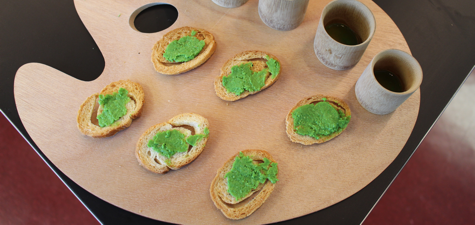
Super Chef returned to CREA (see Education Week: Sous Vide at CREA to sample the dishes being created by chef instructors in the CREA Test Kitchen. The chefs used both sous vide and molecular gastronomy techniques that they are incorporating into their curriculum. The kitchen is spacious and meticulously clean with ample space for the chefs and students. It is lined with equipment like a laboratory. Chefs in white scientist coats were finishing off their creations.
Up first was a lovely hand roll of sushi rice and sous vide salmon. The fish was luscious and rich, yet lighter and less fatty then when it is raw. Not everyone can eat raw fish (like many pregnant women) and the cooked fish can stay fresh longer. There were also surprising cubes of sushi rice hiding pork belly, also prepared with sous vide.
Next was a glass dome filled with smoke. Inside was a single deviled egg topped with crisp pork belly and chives. As the smoke dissipates, you pop the deviled egg in your mouth and both smell and taste the smoky flavor.
Super Chef was given a spoon filled with an olive – it was olive oil in a membrane that disappeared on your tongue as soon as you ate it. Chef Edgar Steele, who worked at Jose Andres‘ minibar as well as a season at Ferran Adria‘s elbulli in Spain, is an instructor for CREA. He demonstrated the technique of spherification, this time with a tiny oyster, mango juice, and mint. The trio is encased in a thin, tasteless membrane that explodes, so that the mango, oyster, and mint are delivered in one tiny bite of sweet and salty chewiness.
Chef Bruno Bertin broke a chicken egg, prepared sous vide, that was perched on a little white stand (made by a 3D-printer). He poured out a perfectly runny poached egg, topped by sea salt and a reduced Asian red wine sauce flavored with fish sauce, ginger, and shallot, and topped with fried pork belly.
In another area of the kitchen, a centrifuge spins full of vials of green liquid that turned out to be producing pea juice, pea butter, and concentrated pea “meat.” The pea juice is so sweet it can be used to make desserts like foams, or in amuse buche, or just sipped like the ultimate green juice.
Lastly, James Chen, Director of Educational Development at CREA demonsratated how to use a rotary evaporator. A contraption held a balloon-like bottle filled with apple cider. The cider slowly spins in a heated water bath. As it evaporates, the liquid was chilled and using centrifugal force, dripped into another bottle. In it, the clear, colorless liquid that collected tasted of the perfume of apples. The apple cider is reducing to a thick butter that is eaten on toast. Since its not cooked down, like traditional apple butter, it retains the fresh, crisp taste of apple cider.

